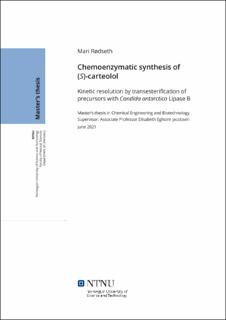| dc.contributor.advisor | Jacobsen, Elisabeth Egholm | |
| dc.contributor.author | Rødseth, Mari | |
| dc.date.accessioned | 2021-09-28T18:30:12Z | |
| dc.date.available | 2021-09-28T18:30:12Z | |
| dc.date.issued | 2021 | |
| dc.identifier | no.ntnu:inspera:77798797:37542963 | |
| dc.identifier.uri | https://hdl.handle.net/11250/2785486 | |
| dc.description.abstract | Det har vært et økt fokus på syntese av enantiomert rene aktive farmasøytiske ingredienser de siste tiårene. Kombinert med et økende behov for miljøvennlig kjemi så er det av stor interesse å utforske biokatalytisk syntese og oppløsning av biologisk aktive stoffer. Som et bidrag til videre forskning på slike prosesser vil dette prosjektet fokusere på kjemoenzymatisk syntese av beta-blokker (S)-carteolol ((S)-4).
Syntesen gikk over tre trinn, som er vist med reaksjonsbetingelser og utbytter i Skjema 0.4. I det første syntesetrinnet dannes 5-(3-kloro-2-hydroksypropoksi)-3,4-dihydroquinolin-2(1H)-on (2a) og 5-hydroksy-(2,3-epoksypropoksi)-3,4-dihydroquinolin-2(1H)-on (2b) ved en SN2 substutisjon av epiklorhydrin med 5-hydroksy-3,4-dihydroquinolin-2(1H)-on (1) i basisk miljø. Reaksjonen ble utført med 2 ekvivalenter epiklorhydrin og 0.3 ekvivalenter natriumhydroksid løst i en vann- og dimetylsulfoksidløsning [3:2], ved romtemperatur i 24 timer. En 2a:2b [75:24] produktblanding ble oppnådd i 91% av forventet mengde etter justering for produktkomposisjon.
I det andre syntesetrinnet ble klorhydrin 2a formet ved åpning av epoksid 2b med litiumklorid i surt miljø. Reaksjonen ble utført med 2 ekvivalenter litiumklorid og 2 ekvivalenter eddiksyre løst i acetnitril, ved romtemperatur i 24 timer. Klorhydrin 2a ble oppnådd i 83% av forventet mengde etter justering for komposisjonen av startmaterialet, og i 76% totalt utbytte over begge trinn.
Klorhydrin (R)-2a ble oppnådd ved enzymatisk kinetisk oppløsning i det tredje syntesetrinnet. Rasemisk 2a ble enantioselektivt omestret med vinylbutanoat og formet ester (S)-1-kloro-3-((2-okso-1,2,3,4-tetrahydroquinolin-5-yl)oksy)propan-2-ylbutanoat ((S)-3). Reaksjonen ble utført med 5 ekvivalenter vinylbutanoat og Candida antarctica Lipase B (1.0 g / 1.0 mmol 2a) i tørr acetnitril, ved 37 °C og 200 rpm i 74 timer. Klorhydrin (R)-2a ble oppnådd i 38% utbytte og med 97% ee. Ester (S)-3 ble oppnådd i 43% utbytte og 77% ee. En
enantiomerisk ratio på 27 be kalkulert.
I det fjerde og endelige syntesetrinnet ble (S)-4 dannet ved alkylering av tert-butylamin med klorhydrin (R)-2a. Reaksjonen ble utført med 20 ekvivalenter tert-butylamin løst i metanol, ved 50 °C i 22 timer. Produktet ble ekstrahert og renset ved flash kromatografi (iso-propanol:n-heksan:dietylamin [80:20:3]). (S)-4 ble oppnådd i 25% utbytte og 88% ee.
Syntese av rasemisk 4 ble utført under de samme reaksjonsbetingelsene, se Skjema 0.5. Etter ekstraksjon ble rasemisk 4 oppnådd i 77% utbytte.
Syntese av 5-(3-uoro-2-hydroksypropoksi)-3,4-dihydroquinolin-2(1H)-on (2d) ble utforsket. Reaksjonen ble utført med 2 ekvivalenter epifluorhydrin og 0.3 ekvivalenter natriumhydroksid løst i en vann- og dimetylsulfoksidløsning [3:2], ved romtemperatur i 24 timer, se Skjema 0.6. Fluorhydrin 2d ble oppnådd i et 75% utbytte. | |
| dc.description.abstract | There has been an increased focus on synthesis of enantiopure active pharmaceutical ingredients in the last few decades. Combined with the growing demand for environmentally friendly chemistry, it is of great interest to explore biocatalytic synthesis and resolution of biologically active compounds. As a contribution to the further examination of such processes, this project focused on the chemoenzymatic synthesis of beta-blocker (S)-carteolol ((S)-4).
The synthesis was carried out in four steps, indicated with reaction conditions and yields in Scheme 0.1. In the first synthesis step, 5-(3-chloro-2-hydroxypropoxy)-3,4-dihydroquinolin-2(1H)-one (2a) and 5-hydroxy-(2,3-epoxypropoxy)-3,4-dihydroquinolin-2(1H)-one (2b) were formed by an SN2 substitution of epichlorohydrin with 5-hydroxy-3,4-dihydroquinolin-2(1H)-one (1) in a basic environment. The reaction was performed with 2 equivalents epichlorohydrin and 0.3 equivalents sodium hydroxide dissolved in a water- and dimethyl sulfoxide solution [3:2], at room temperature for 24 hours. A 2a:2b [75:24] product mixture was obtained in 91% of the expected amount when adjusted for product composition.
In the second synthesis step, epoxide 2b was opened with lithium chloride in an acidic environment, forming chlorohydrin 2a. The reaction was performed with 2 equivalents lithium chloride and 2 equivalents acetic acid dissolved in acetonitrile, at room temperature for 24 hours. Chlorohydrin 2a was obtained in 83% of the expected amount when adjusted for the composition of starting material, and in 76% total yield across both steps.
Chlorohydrin (R)-2a was obtained by enzymatic kinetic resolution in the third synthesis step. Racemic 2a underwent an enantioselective transesterification reaction with vinyl butanoate, forming ester (S)-1-chloro-3-((2-oxo-1,2,3,4-tetrahydroquinolin-5-yl)oxy)propan-2-yl butanoate ((S)-3). The reaction was performed with 5 equivalents vinyl butanoate and Candida antarctica Lipase B (1.0 g / 1.0 mmol 2a) in dry acetonitrile, at 37 °C and with 200 rpm for 74 hours. Chlorohydrin (R)-2a was obtained in 38% yield and with 97% ee. Ester (S)-3 was obtained in 43% yield and with 77% ee. An enantiomeric ratio of 27 was calculated.
In the fourth and final synthesis step, (S)-4 was formed by alkylation of tert-butylamine with chlorohydrin (R)-2a. The reaction was performed with 20 equivalents tert-butylamine in methanol, at 50 °C for 22 hours. The product was extracted and purified by ash chromatography (iso-propanol:n-hexane:diethylamine [80:20:3]). (S)-4 was obtained in 25% yield and with 88% ee.
Synthesis of racemic 4 was performed with the same reaction conditions, see Scheme 0.2. After extraction, racemic 4 was obtained in 77% yield.
Synthesis of 5-(3-uoro-2-hydroxypropoxy)-3,4-dihydroquinolin-2(1H)-one (2d) was also explored. The reaction was performed with 2 equivalents epifluorohydrin and 0.3 equivalents sodium hydroxide, at room temperature for 24 hours, see Scheme 0.3. Fluorohydrin 2d was obtained in a 75% yield. | |
| dc.language | eng | |
| dc.publisher | NTNU | |
| dc.title | Chemoenzymatic synthesis of (S)-carteolol: Kinetic resolution by transesterification of precursors with Candida antarctica Lipase B | |
| dc.type | Master thesis | |
